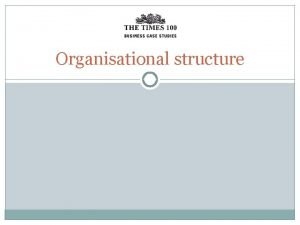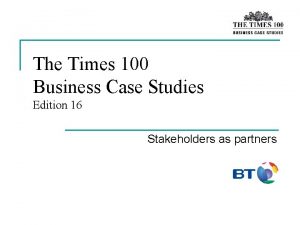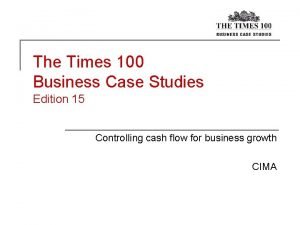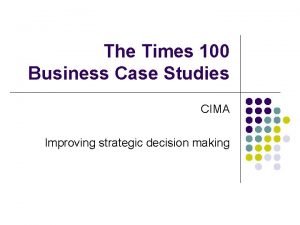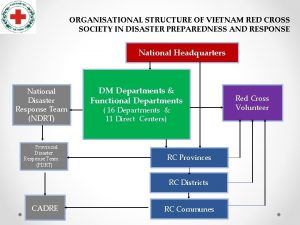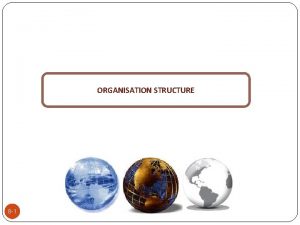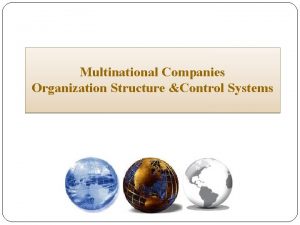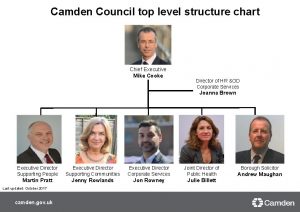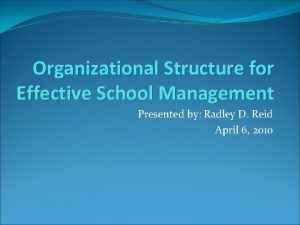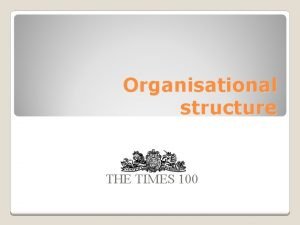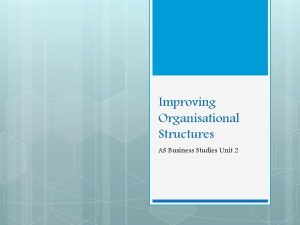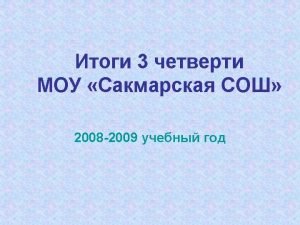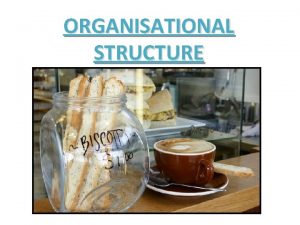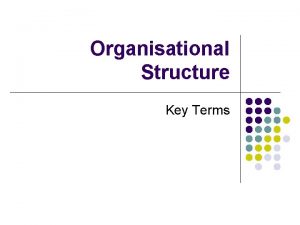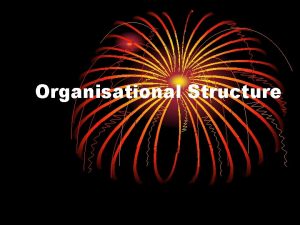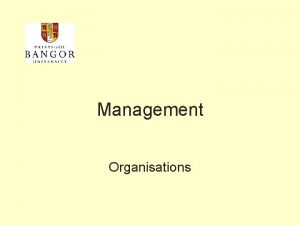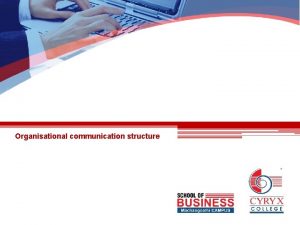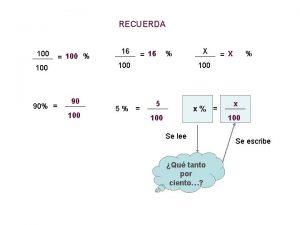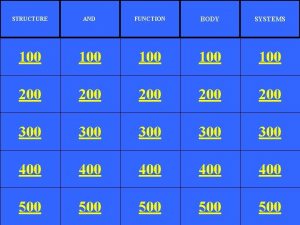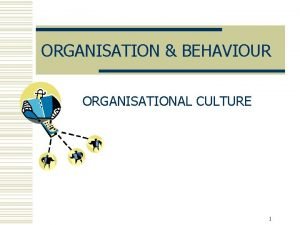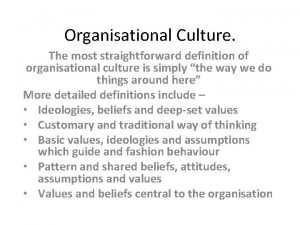Organisational structure THE TIMES 100 Internal structure of





















- Slides: 21

Organisational structure THE TIMES 100

Internal structure of firms In small firms: Each worker may undertake a range of roles The structure may be informal and fluid As firms grow bigger: The roles and responsibilities of each worker must become clearer A more formal structure is necessary THE TIMES 100

Workforce roles Leadership & managerial roles include: Supervisors Have one or more lower grade workers reporting directly to them Team leaders Support a group of workers within a firm Managers Manage particular areas of a business Directors Appointed by shareholders to run the business on their behalf THE TIMES 100

Functional areas A function is the specific job of a person or department. The main functional areas in organisations are: Finance Human resources Sales & marketing Production and operations THE TIMES 100

Organisation charts Board of directors HR Manager Finance Manager 4 HR Officers 6 Accounts Clerks Marketing Manager Operations Director Factory A Manager 3 Quality controllers 20 Factory workers Factory B Manager 2 Quality controllers 8 Sales Reps 15 Factory workers THE TIMES 100

Organisation structure Organisation charts - pictorial representations of the job roles and lines of responsibility within a business. Hierarchy – an organisation structured in layers, with those at the top having greater authority than workers in lower levels THE TIMES 100

Organisation structure Span of control – the number of workers one manager is directly responsible for Chain of command – the line down which instructions are passed through the layers in the hierarchy THE TIMES 100

Tall organisations These have: Many layers Small spans of control Characteristics of tall organisations: High levels of control (appropriate for unskilled workers) More opportunities for promotion Poor communication as information has to pass through the many layers THE TIMES 100

Flat organisations have: Few layers Large spans of control Characteristics of flat organisations: Low levels of control (suitable for skilled, experienced & motivated workers) Better communication Managers must delegate work due to larger spans of control, motivating employees THE TIMES 100

De-layering involves removing one or more layers of middle managers De-layering can: ü Cut the costs of paying many managers ü Improve communication ü Empower the remaining workers if they are given extra responsibilities X Result in a loss of experienced, skilled managers THE TIMES 100

Matrix structures use a project-based approach to organisational design Project teams are made up of representatives from the different functional areas Matrix teams run alongside the traditional functional structure THE TIMES 100

Matrix structures Advantages of matrix structures Drawback of matrix structures • Staff from all departments can work on the project, leading to quick decisionmaking • Split loyalties as workers have both project team leaders and their functional managers • Workers may be able to use their skills and abilities better • Administration of matrix management can be more expensive THE TIMES 100

Centralisation Authority for decision-making remains with senior managers Benefits of centralisation Drawbacks of centralisation Firms can benefit from economies of scale Local differences may not be taking into account Ensures the activities Employees cannot use their throughout the business fit with knowledge of working at the organisation’s objectives ‘coalface’ Quick decisions can be made by Workers may become demanagers who are skilled at motivated decision making THE TIMES 100

Decentralisation Authority for decision-making is delegated down the hierarchy Benefits of decentralisation Drawbacks of decentralisation Staff are empowered to make decisions which may be motivating A consistent corporate message may not be delivered throughout the firm Local conditions can be considered when making decisions Fewer chances of benefiting from economies of scale The experience of all workers is utilised Workers down the hierarchy may be less skilled at decision-making THE TIMES 100

Flexible workforces Flexibility can be gained by using: Core & peripheral workers Outsourcing Home-working Core workers: • Usually full time and permanent • Know the firm well • Typically managers & specialists • Business functions are provided by other specialist organisations, e. g. cleaning firms. • Employees work from home Peripheral workers: • Bought in only when needed • Employed on a temporary basis • May be more cost effective than carrying out these functions in-house. • Usually relies on the use of advanced technology and communication • Provides flexibility to both workers and their employers THE TIMES 100

Organisational structure in context THE TIMES 100

Organisational structure Using the organisation chart in the Specsavers case study to demonstrate your answers, define the terms: Hierarchy Delegate Chain of command Span of control THE TIMES 100

Centralisation at Specsavers uses a joint venture approach. Business owners buy into the Specsavers brand in order to run Specsavers stores. Explain how the business owners benefit from the centralisation of some activities. Use the Specsavers case study to help you THE TIMES 100

Decentralisation at Specsavers Why is it important that there is some decentralisation within Specsavers? Use the case study to help you THE TIMES 100

Job roles at Specsavers There a wide range of both professional and support roles within Specsavers. Explain what is meant by a job description and explain what is likely to be listed in a job description for either an Optometrist or an Optical Assistant. Use the case study to help you THE TIMES 100

Useful resources Organisational structure lesson suggestions and activities (The Times 100) Specsavers case study (The Times 100) Specsavers website THE TIMES 100
 100 100 100 100 100
100 100 100 100 100 Internal organisational structures
Internal organisational structures Mat0022
Mat0022 Times 100 case studies
Times 100 case studies Times 100 case studies
Times 100 case studies Times 100 case studies
Times 100 case studies Compare and contrast pakistani and indian music
Compare and contrast pakistani and indian music Times 100 case studies
Times 100 case studies Ouh organisational structure
Ouh organisational structure Merlin entertainments organisational structure
Merlin entertainments organisational structure Role of nabard
Role of nabard Red cross organization structure
Red cross organization structure Logistic structure
Logistic structure Domestic structure
Domestic structure Mahindra investor presentation
Mahindra investor presentation Ethekwini municipality organisational structure
Ethekwini municipality organisational structure Chief executive camden council
Chief executive camden council Buurtzorg organization structure
Buurtzorg organization structure School organizational chart
School organizational chart Specsavers organisational structure
Specsavers organisational structure Organisational structure business studies
Organisational structure business studies Health education england organisational structure
Health education england organisational structure

